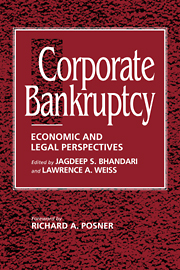Book contents
- Frontmatter
- Contents
- List of tables and figures
- Foreword by the HONORABLE RICHARD A. POSNER
- Preface
- Part I The role of credit
- Part II Bankruptcy as a reflection of the creditors' implicit bargain
- Part III Beyond the basic creditors' bargain
- 9 Bargaining after the fall and the contours of the absolute priority rule
- 10 On the nature of bankruptcy: An essay on bankruptcy sharing and the creditors' bargain
- 11 A simple noncooperative bargaining model of corporate reorganizations
- 12 Commentary on “On the nature of bankruptcy”: bankruptcy, priority, and economics
- 13 Bankruptcy and risk allocation
- 14 The corporate bankruptcy decision
- 15 Bargaining over equity's share in the bankruptcy reorganization of large, publicly held companies
- 16 Bankruptcy resolution: Direct costs and violation of priority of claims
- 17 The costs of conflict resolution and financial distress: Evidence from the Texaco-Pennzoil litigation
- 18 Survey of evidence on business bankruptcy
- Part IV Workouts or bargaining in the shadow of bankruptcy
- Part V Alternatives to bankruptcy and the creditors' bargain
- Part VI Experience of other countries
- Index
16 - Bankruptcy resolution: Direct costs and violation of priority of claims
Published online by Cambridge University Press: 10 December 2009
- Frontmatter
- Contents
- List of tables and figures
- Foreword by the HONORABLE RICHARD A. POSNER
- Preface
- Part I The role of credit
- Part II Bankruptcy as a reflection of the creditors' implicit bargain
- Part III Beyond the basic creditors' bargain
- 9 Bargaining after the fall and the contours of the absolute priority rule
- 10 On the nature of bankruptcy: An essay on bankruptcy sharing and the creditors' bargain
- 11 A simple noncooperative bargaining model of corporate reorganizations
- 12 Commentary on “On the nature of bankruptcy”: bankruptcy, priority, and economics
- 13 Bankruptcy and risk allocation
- 14 The corporate bankruptcy decision
- 15 Bargaining over equity's share in the bankruptcy reorganization of large, publicly held companies
- 16 Bankruptcy resolution: Direct costs and violation of priority of claims
- 17 The costs of conflict resolution and financial distress: Evidence from the Texaco-Pennzoil litigation
- 18 Survey of evidence on business bankruptcy
- Part IV Workouts or bargaining in the shadow of bankruptcy
- Part V Alternatives to bankruptcy and the creditors' bargain
- Part VI Experience of other countries
- Index
Summary
Introduction
This chapter examines the resolution of bankruptcy for thirty-seven New York Stock Exchange (NYSE) and American Stock Exchange (Amex) firms that filed petitions under the 1979 Bankruptcy Code (hereafter “the Code”) between November 1979 and December 1986. New evidence is provided on the direct costs of bankruptcy and the violation of priority of claims.
The costs of bankruptcy have long been viewed as a potential determinant of the pricing of a firm's debt and of its capital structure. Bankruptcy costs are direct and indirect. Direct costs encompass the legal and administrative fees, including the costs of lawyers, accountants, and other professionals involved in the bankruptcy filing. Indirect costs include a wide range of unobservable opportunity costs.
Prior studies report direct costs of bankruptcy ranging from 4 percent to 25 percent. This study is the first to examine direct costs under the new Code and to cover a broad range of industrial firms. For the firms examined, direct costs average 3.1 percent of the book value of debt plus the market value of equity at the end of the fiscal year preceding bankruptcy. As Warner (1977a) demonstrates, such small direct costs have virtually no impact on the pricing of claims and capital structure prior to bankruptcy.
The firm's cost of capital and its capital structure may also be affected if priority of claims is not maintained in bankruptcy. Priority of claims is violated when senior claimants' are not fully satisfied before junior claimants receive any payment.
- Type
- Chapter
- Information
- Corporate BankruptcyEconomic and Legal Perspectives, pp. 260 - 278Publisher: Cambridge University PressPrint publication year: 1996
- 39
- Cited by



